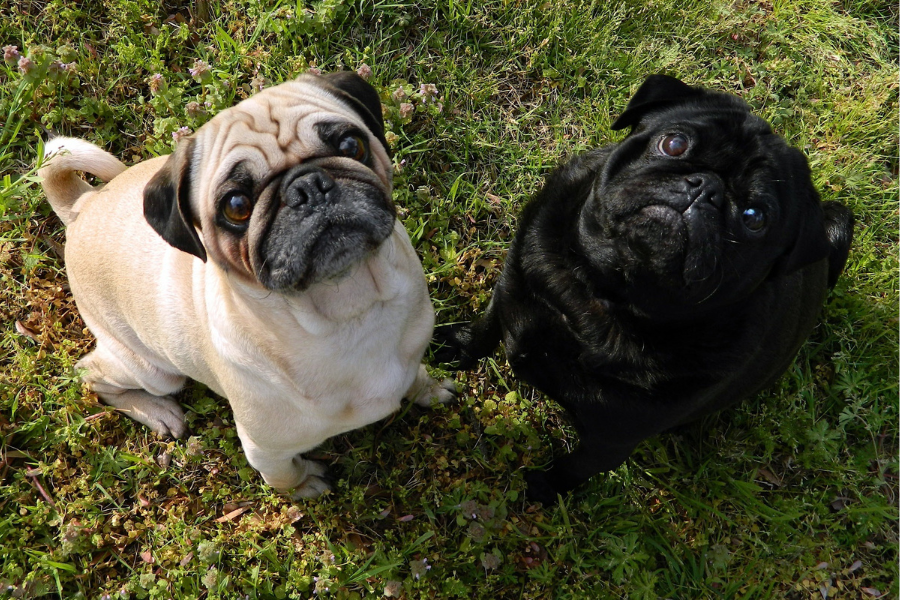Understanding Pug Anatomy: Why They’re So Unique
The Pug’s round head, short muzzle, and stocky frame make them instantly recognisable — but these same features are what lead to many Pug breed health issues. This compact design affects nearly every system in their body, from their airways and eyes to their skin and tail.
This condition is called brachycephaly — literally meaning “short-headed.” While it gives Pugs their endearing, squished-nose look, it also narrows their air passages, causes eye protrusion, and traps heat easily.
In short, what makes Pugs cute can also make them complicated.
1. Pug Breathing Problems: The Airway Challenge
Perhaps the best-known issue among all health issues with Pugs is their breathing difficulty. Most Pugs experience some form of Brachycephalic Obstructive Airway Syndrome (BOAS), a condition where shortened nasal passages and an elongated soft palate restrict airflow.
Symptoms include:
- Loud snoring and snorting
- Rapid breathing even at rest
- Gagging or coughing during excitement or exercise
- Overheating quickly in warm weather
In serious cases, BOAS can lead to collapse or require surgical correction to open the airways.
How to help:
Keep your Pug at a healthy weight, avoid exercising in the heat, and ensure they have a cool environment to rest. Regular vet check-ups are essential to monitor airway health.
Learn more about how heat and breathing affect dogs in our blog Why Do Dogs Pant? — it’s especially relevant for brachycephalic breeds like Pugs.
For long-term protection, consider comprehensive Dog Insurance that covers insurance for breed-related conditions and respiratory issues.
2. Pug Eye Problems: The Cost of Cuteness
Those big, soulful eyes that make Pugs so expressive also make them vulnerable. Because their eyes are slightly protruded, they’re at higher risk of injuries and conditions such as:
- Corneal ulcers from scratches or debris
- Dry eye (keratoconjunctivitis sicca) due to poor tear production
- Proptosis, where the eye can actually pop out of its socket after trauma
- Pigmentary keratitis, a progressive darkening of the cornea
These Pug eye problems often require long-term medication or even surgery to prevent blindness.
Prevention tips:
Keep their face clean, avoid harsh play, and watch for excessive blinking, redness, or cloudy eyes. Immediate veterinary care can save their vision — and insurance can save you from the financial stress of urgent treatments.
Regular preventative check-ups are vital. Read Preventative Pet Care for tips on early detection and routine care to help your Pug live comfortably.
3. Pug Skin and Wrinkle Care
Wrinkles are part of a Pug’s charm — but they’re also breeding grounds for bacteria and yeast if not properly cleaned. Common health issues with Pugs include:
- Skin fold dermatitis, an infection that occurs between moist folds
- Allergies, often food- or environment-related
- Demodectic mange, a parasitic skin condition
To prevent these problems, gently wipe your Pug’s wrinkles daily with a damp cloth and ensure they’re thoroughly dry afterward. High-quality diets and regular grooming can also improve skin health.
4. Pug Teeth Issues: Dental Dangers in a Small Jaw
Because Pugs have short snouts and crowded teeth, dental disease is one of the more underestimated 10 problems of Pug owners face. Plaque and tartar can build up quickly, leading to:
- Bad breath
- Tooth decay or loss
- Painful gum infections
- Difficulty eating
Routine dental cleaning and vet check-ups are essential. Brushing your Pug’s teeth regularly at home can also make a big difference.
Since dental surgery can be costly, Pet-n-Sur Dental 360 Cover can help you stay ahead of these recurring Pug teeth issues.
5. Pug Tail Problems: More Than Just a Cute Curl
The tight, corkscrew tail of a Pug isn’t just decorative — it’s a result of a spinal malformation called hemivertebrae. While it often causes no issues, in some Pugs it can lead to:
- Back pain
- Weakness in hind legs
- Incontinence
In severe cases, pug tail problems may require imaging, physiotherapy, or even surgery. Regular monitoring and prompt attention to mobility changes are crucial.
6. Obesity: The Silent Aggravator
Due to their small stature and big appetite, many Pugs struggle with weight gain — and this exacerbates nearly every other condition. Obesity worsens Pug breathing problems, stresses their joints, and increases the risk of diabetes.
Keep meals portioned, treat snacks as rare rewards, and engage your Pug in gentle daily exercise.
If your Pug is anxious or sensitive, visit our blog Help Your Dog Cope with Loud Noises — calm dogs are less likely to overeat or stress eat.
7. Spinal and Joint Issues
The Pug’s compact frame and curled spine predispose them to skeletal concerns such as:
- Hip dysplasia
- Luxating patella (kneecap slipping out of place)
- Intervertebral disc disease (IVDD)
These can cause lameness, stiffness, or paralysis in severe cases. Managing these conditions early with physiotherapy or surgery can be costly — but insurance coverage for hereditary and orthopedic issues can make it manageable.
8. Neurological Conditions
Pugs are also susceptible to Pug Dog Encephalitis (PDE), a rare but fatal inflammation of the brain that mainly affects young adults. Symptoms include seizures, disorientation, and lethargy.
While PDE isn’t preventable, early diagnosis and supportive care can improve quality of life. Comprehensive pet insurance ensures access to neurological diagnostics and treatments without financial hesitation.
9. Digestive and Allergy Problems
From food sensitivities to chronic flatulence, gastrointestinal issues are among the 10 problems of Pug that owners frequently encounter. Many Pugs benefit from grain-free or hypoallergenic diets, but proper diagnosis requires vet testing.
Allergies can also manifest as skin or ear infections, often requiring repeat treatments — another reason why a solid insurance plan helps ease long-term costs.
10. Sleep and Snoring: Not Always Cute
Every Pug owner knows the sound — that rhythmic snore that can shake the whole room. But excessive snoring or interrupted sleep may indicate Pug breathing problems or obesity-related airway obstruction.
Understanding their unique sleep patterns can help detect early warning signs. See The Science Behind Cat and Dog Sleep Patterns to learn how breathing affects your Pug’s rest.
How to Take Care of a Pug Puppy
Early care is everything. Knowing how to take care of a Pug puppy can prevent lifelong health struggles. Start with:
- Early vet visits — vaccinations, deworming, and health screenings. (See our guide: Everything You Need to Know About Dog Vaccinations).
- Proper diet and exercise — avoid overfeeding; use short, frequent walks.
- Socialisation and comfort — avoid overexertion, especially in heat or excitement.
- Insurance from the start — early enrolment means your puppy’s hereditary conditions are covered before symptoms appear.
Why Pet Insurance Is Essential for Pugs
Owning a Pug comes with immense joy — and a fair share of responsibility. Their medical vulnerabilities make vet visits and occasional surgeries almost inevitable. From airway correction to corneal surgery or spinal imaging, these costs can add up quickly.
That’s why a comprehensive Dog Insurance plan from Pet-n-Sur is invaluable. It helps manage the financial side of the health issues with Pugs, ensuring your furry friend always gets the care they deserve without compromise.
Pet-n-Sur covers hereditary and breed-related conditions, respiratory issues, and even dental treatments — giving you confidence that your Pug’s wellbeing is protected for life.
Final Thoughts
Pugs are irresistibly affectionate and endlessly entertaining companions — but they rely on attentive owners who understand their unique vulnerabilities. By being aware of the 10 problems of Pug health, taking preventative steps, and investing in the right insurance, you’ll ensure your Pug lives a comfortable, happy life.
With Pet-n-Sur, you’re not just buying a policy — you’re gaining a partner who understands the quirks and challenges of your favourite wrinkled-face friend.
Explore our Dog Insurance plans today and give your Pug the lifelong protection they deserve.



